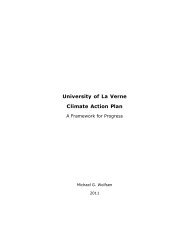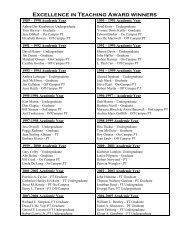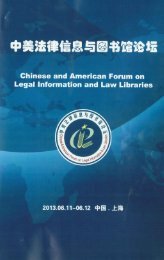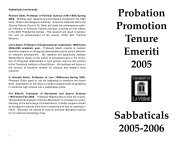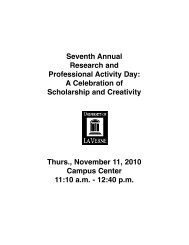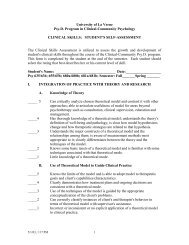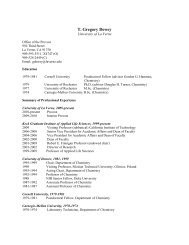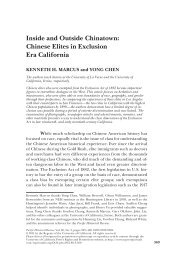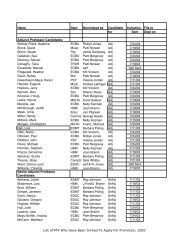Sample Lab Report #1 - Faculty Web Hosting - University of La Verne
Sample Lab Report #1 - Faculty Web Hosting - University of La Verne
Sample Lab Report #1 - Faculty Web Hosting - University of La Verne
Create successful ePaper yourself
Turn your PDF publications into a flip-book with our unique Google optimized e-Paper software.
In the <strong><strong>La</strong>b</strong> Syllabus, I gave you a lot <strong>of</strong> details regarding the writing <strong>of</strong> your lab reports. I know you<br />
have probably been overwhelmed with information the first week or so <strong>of</strong> this course. I will refer<br />
you to this sample lab report for <strong><strong>La</strong>b</strong> <strong>#1</strong>, to the lab syllabus for a list <strong>of</strong> all <strong>of</strong> the items you need to<br />
include in your lab reports, and to the lab directions for <strong><strong>La</strong>b</strong> <strong>#1</strong> listed on the Chemistry 103<br />
<strong>Web</strong>site. If, after reviewing the resources listed, you have any questions regarding the format<br />
and/or content <strong>of</strong> the lab reports, please contact me.<br />
I did conversions listed below. But, there is usually more than one way to do get the same answer in<br />
mathematics. So, if you find other ways to get the same result, then that is fine. I just didn’t want<br />
this to confuse you. Also, as you read in Chapter 2, you should always let your calculator carry along<br />
all <strong>of</strong> the numbers or digits in a set <strong>of</strong> calculations, and then round once you have the answer.<br />
Remember, if you round at each step, then you can determine a result that is different than if you<br />
only rounded after you had performed all <strong>of</strong> the calculations.<br />
A Final Note before Moving On: As you can see in this sample report, I attempted to give you<br />
enough information in the purpose and procedure sections listed so someone could probably take<br />
this experiment and report, and reproduce the results. If you write your report in such a way that<br />
you think a stranger to this course, with the necessary skills, could read you report and reproduce<br />
your results, then you have probably included enough information in your report. This is typically<br />
the most common error students make on their lab reports. That is, they leave <strong>of</strong>f important details<br />
and pieces <strong>of</strong> information, which are crucial for an outside reader, me, to completely understand<br />
what you did, what you observed and experienced, how you did the experiment, how you explained<br />
your results and observations, etc. As I have said before, you can probably not give me too much<br />
information in your report. So, make sure you always include all <strong>of</strong> the steps you took, the<br />
observations you made, etc. when you are writing up your experiment and results.<br />
The following is a sample lab report. It is in an acceptable format and can be used as a guide for<br />
what I am looking for in your lab report.<br />
Instructor: Mark M. Nelson<br />
Student: Great Student<br />
4-Digit Code: 0007<br />
e-mail: greatstudent@ulv.edu<br />
Date: March 17, 2007<br />
<strong>Sample</strong> <strong><strong>La</strong>b</strong> Write-up<br />
Chemistry 103 <strong><strong>La</strong>b</strong>oratory, Spring 2007<br />
<strong><strong>La</strong>b</strong>oratory <strong>#1</strong><br />
Experiment <strong>#1</strong>: English to Metric Unit Conversions<br />
Purpose: In this experiment, I learned how to put into practice the conversion from one set <strong>of</strong> units<br />
to another, using the techniques discussed in all <strong>of</strong> the material for Chapter 2 and the conversion<br />
factors listed in the text. In particular, I was asked to gather 5 or 6 items and convert from the<br />
English units listed on the product label to the Metric units listed in parenthesis.<br />
Procedure: I gathered 5 items from my home that had a label on each product which listed both the<br />
English and Metric units. I made sure I picked items with varying weights and sizes, so I would do
various conversions, rather than the same type <strong>of</strong> conversion 5 or 6 times in a row. I took the<br />
English unit value listed and used the appropriate conversion factors from the tables in the textbook<br />
and used the techniques I learned in the lecture notes for Chapter 2 and the corresponding material<br />
in the text to convert them to the Metric units listed on the product. The tables I used for obtaining<br />
the conversion factors were in Chapter 2, Table 2.7, and in the tables at the end <strong>of</strong> the book on the<br />
inside cover. However, I mostly used the tables that are located on the back cover <strong>of</strong> you textbook<br />
because there were more conversion factors and they had more significant digits than the ones listed<br />
in Table 2.7. I then compared the Metric units I calculated to the units listed on the product to see<br />
if there was agreement, after appropriate rounding <strong>of</strong> the results.<br />
Materials Used: The products I chose were: A large bottle <strong>of</strong> Tide HE laundry detergent, a small<br />
can <strong>of</strong> Dole Sliced Pineapples, a relatively large bag <strong>of</strong> Yesterday’s News Cat Litter, a bottle <strong>of</strong><br />
Propel Fitness Water, and a large bottle <strong>of</strong> generic White Vinegar. I also needed to use a calculator<br />
to perform the calculations listed below and the tables with the conversion factors that I listed in the<br />
Procedure Section above.<br />
Calculations for Experiment and Observations:<br />
1) The bottle <strong>of</strong> Tide HE laundry detergent said it contained 200 Fl. Oz., which was equal to<br />
1.56 gallons, and equal to 5.91 liters. To perform these conversions, I need to know how to<br />
convert Fl. Oz. to gallons, and then gallons to liters. The conversion factors I found to<br />
accomplish this were from the table on the back cover <strong>of</strong> the text: 1 quart = 32 fl. oz., 1<br />
gallon = 4 quarts, and 1 gallon = 3.7854 liters. I first converted the fluid ounces to quarts<br />
and then converted this to gallons. Once I had this done, then I could convert this to liters:<br />
1 qt 1 gal<br />
200 fl oz.<br />
× × = 1.5625 gal = 1. 56 gallons<br />
32 fl.<br />
oz.<br />
4 qt<br />
As you can see, I rounded this down appropriately to get the same result as the product label, 1.56<br />
gallons. Next, I need to convert the gallons to liters, using the full result from above:<br />
3.7854 L<br />
1 .5625 gallons × = 5.914687 L = 5. 91 Liters<br />
1 gal.<br />
As you can see, I did not use the rounded value <strong>of</strong> gallons in the second conversion, I used the<br />
entire number stored in my calculator, and after appropriate rounding down I got the same result as<br />
was listed on the package. That is, 200 Fl. Oz. = 1.56 Gal. = 5.91 Liters<br />
2) The can <strong>of</strong> Dole Pineapples said 15 ounces, which was equal to 425 grams. In order to do<br />
this conversion, I needed to know how to relate ounces (weight not fluid) and grams. To<br />
accomplish this, the conversion factors I found on the back cover <strong>of</strong> the text were: 1 lb = 16<br />
oz. and 1 lb. = 453.59 grams. I used both <strong>of</strong> these conversion factors to first convert from<br />
ounces to pounds and then pounds to grams. The calculation is:<br />
1 lb 453.59 grams<br />
15 oz.<br />
× ×<br />
= 425.240625 grams = 425 grams<br />
16 oz.<br />
1 lb
As you can see, I rounded this down appropriately to get the same result as the product label, 15<br />
ounces = 425 grams.<br />
3) The bag <strong>of</strong> cat litter said it contained 26.4 pounds, which was equal to 11.9 kg. In order to<br />
do this conversion, I needed to know how to relate pounds to kilograms. The conversion<br />
factors I found were on the back cover <strong>of</strong> the text: 1 lb = 0.45359 kg or 1 kg = 2.2046 lbs. I<br />
used the first conversion factor listed above in the calculation below, but I could have used<br />
either one appropriately and still obtained the exact same result.<br />
0.45359 kg<br />
26 .4 lb.<br />
×<br />
= 11.9747 kg = 12. 0 kg<br />
1 lb.<br />
As you can see, I rounded this appropriately to get a result that was 0.1 kg higher than the value<br />
listed by the product’s manufacturer. According to my calculations, I found that 26.4 pounds is<br />
equal to 12.0 kilograms (after rounding correctly). However, the product listed 26.4 pounds is equal<br />
to 11.9 kilograms.<br />
4) The bottle <strong>of</strong> Propel Fitness Water said it contained 23.7 fluid ounces and was equal to 700<br />
milliliters. In order to do this conversion, I needed to know how to relate fluid ounces and<br />
milliliters. To accomplish this, the conversion factors I found on the back cover <strong>of</strong> the text<br />
were: 1 qt = 32 fl. oz. = 0.94635 liters, and 1 liter = 1000 mL. I used these conversion<br />
factors to first convert from fluid ounces to quarts, then quarts to liters, and lastly, from<br />
liters to milliliters. The calculation is:<br />
1 qt 0.94635 liters 1000 milliliters<br />
23 .7 fl.<br />
oz.<br />
× ×<br />
×<br />
= 700.89 mL = 701 mL<br />
32 fl.<br />
oz.<br />
1 qt<br />
1 liter<br />
As you can see, after I rounded this up appropriately I got a result that was 1 mL higher than listed<br />
on the product label for Propel Water, 23.7 fluid ounces = 701 mL.<br />
5) My final product is the generic bottle <strong>of</strong> white vinegar. The bottle <strong>of</strong> vinegar states 1.32<br />
gallons = 5.0 liters. In order to do this conversion, I need to relate gallons and liters. The<br />
conversion factor I found on the back cover <strong>of</strong> the text was: 1 gallon = 3.7854 liters. The<br />
calculation is:<br />
3.7854 Liters<br />
1 .32 gal.<br />
×<br />
= 4.996728 Liters = 5. 0 Liters<br />
1 gal.<br />
As you can see, after I rounded this up appropriately I got the same result listed on the product label<br />
for, 1.32 gallons = 5.0 Liters.<br />
Observations and Results: In two <strong>of</strong> the calculations, I ended up rounding appropriately to get the<br />
value listed on the product label, in two I rounded down, and see the following calculations to see<br />
that it sometimes depends upon what you do. In all cases, the rounding I did was very reasonable
and I did not find any <strong>of</strong> the products where the English units and corresponding Metric units were<br />
greatly different than the ones listed.<br />
The following example shows you what happens if you use conversion factors with a smaller<br />
number <strong>of</strong> significant digits. As you will see below, it really depends on how you do the<br />
calculations, the source for your conversion factors, and when you round your results. Though, we<br />
know we should always try to use conversion factors with the largest number <strong>of</strong> significant digits, to<br />
let our calculator carry all <strong>of</strong> the numbers along during a calculation, and then round correctly (using<br />
the rules from the text and lecture notes).<br />
The following example shows what happens it you do the same type <strong>of</strong> conversion, but you may use<br />
a slightly different method <strong>of</strong> calculating and/or obtain your conversion factors from another<br />
source. In the Propel Fitness Water, 4) above, I determined from the conversion that 23.7 fluid<br />
ounces = 701 mL, yet the product label said it was just 700 mL. One mL is not a big deal, but what<br />
if we did the calculation a different way? Would we get the same result? How did the manufacturer<br />
do the calculation? What conversion factors did they use? Does the Federal Government have a<br />
standard set <strong>of</strong> conversion factors that must be used for product labeling purposes? Or, is the<br />
choice <strong>of</strong> conversion factors and methods used for calculating the units left up to the individual<br />
company?<br />
Anyway, from the calculation for Propel above, I determined 23.7 fluid ounces is 701 mL. What<br />
would happen if I used the data from Table 2.7 in the text to do the same conversion? From Table<br />
2.7, I found 1 liter = 1.06 quarts and I still used 1 qt = 32 fl. oz., and 1 liter = 1000 mL. The<br />
following is a result <strong>of</strong> using the 1 liter = 1.06 quarts:<br />
1 qt 1 liter 1000 milliliters<br />
23 .7 fl.<br />
oz.<br />
× × ×<br />
= 698.7028 mL = 699 mL<br />
32 fl.<br />
oz.<br />
1.06 qt 1 liter<br />
As you can plainly see, I used the same source for my conversion factors, I just used a slightly<br />
different approach, yet now after rounding appropriately, I get that 23.7 fluid ounces is equal to 699<br />
mL and not equal to 700 mL or 701 mL. So, which one is it? Is it 699, 700, or 701? Well, I know<br />
the way I calculated it in 4) above, I used conversion factors with a lot more significant digits than<br />
the conversion factors listed in Table 2.7 <strong>of</strong> the text. So, I would probably say that the 23.7 fl. oz. =<br />
701 mL is the best conversion given the tables in the text. But, as you can plainly see, your result<br />
can vary depending on how many significant digits you have in the conversion factors and how<br />
many you carry along in the calculation.<br />
Explanation <strong>of</strong> Results and Observations: As I stated above, I do not know if the Federal<br />
Government requires manufacturers to use a set method for performing these types <strong>of</strong> conversions.<br />
If they did, then I would need to use that information to replicate the results listed on the product<br />
labels. And, if they don’t, then I would need to know what the manufacturer used for the<br />
conversion factors. All in all, my calculations with appropriate were very close to what was listed on<br />
the product label. I did not find anything which caused me to question the information provided to<br />
me on the label. If I had found great differences, then I would have wanted to know more about<br />
how the conversion was done for the product in question.
All in all, this was an interesting application <strong>of</strong> the conversions from one set <strong>of</strong> units to another set<br />
<strong>of</strong> units discussed in the materials provided for Chapter 2. I saw I could use the conversion factors<br />
listed in the textbook and verify the information being provided to me on the products I used in this<br />
experiment were correct. I enjoyed being able to put something I learned in a class to practice.<br />
That is, to be able to apply something I was studying to real world cases. It might be interesting to<br />
do a web search to see if the Federal Government requires product manufacturers to use a standard<br />
set <strong>of</strong> conversion factors and methods <strong>of</strong> conversion to provide the product label information to the<br />
consumer.<br />
Experiment #2 Search the <strong>Web</strong>: In the directions for <strong><strong>La</strong>b</strong> <strong>#1</strong>, I was asked to search the <strong>Web</strong> for a<br />
chemistry related site and report on my findings.<br />
Purpose: The purpose <strong>of</strong> this exercise was to make me aware <strong>of</strong> the chemistry related information<br />
available to everyone, to make me use a search engine, to make me use the proper queries to get the<br />
information I was looking for, and to determine if the information being provided was reliable and<br />
objective.<br />
Procedure: I actually did two searches. In one search I used Google for my search engine and in<br />
the other search; I used Alta Vista as my search engine.<br />
Search <strong>#1</strong>: In the first search I used Alta Vista as my search engine (www.altavista.com) and I was<br />
interested in finding if anyone had done something creative and fun with the Periodic Table <strong>of</strong><br />
Elements. In particular, I was wondering if anyone had ever made a comic strip <strong>of</strong> any <strong>of</strong> the<br />
elements or something like this. In the search engine I used the following for my search: “periodic<br />
table”+comics By using the quotes around periodic table, I was telling the search engine to look for<br />
sites with this phrase and by using the plus sign with comics following it; I was telling it to also<br />
search for this word or item along with the exact phrase, periodic table. I was surprised by the<br />
number <strong>of</strong> results I obtained. There were 140,000 results, which is just amazing to me. I can’t<br />
believe how much info is available on such a specific item.<br />
Anyway, the first link was a commercial site, which provides s<strong>of</strong>tware for an animated periodic table<br />
for educators to use in a classroom setting. I tried some <strong>of</strong> the free features out and I was pretty<br />
impressed with the amount <strong>of</strong> work that went into creating this product. I believe this would be a<br />
wonderful tool for educators, all the way from grade school to college. They are a local company<br />
located in Carlsbad, CA. They seem to have some great educational s<strong>of</strong>tware for the periodic table<br />
as well as other products. They were very reasonably priced; the Animated Periodic Table sells for<br />
$49.95 with free lifetime upgrades. I was quite impressed with what I saw in their demonstration<br />
product and I assume all <strong>of</strong> the information listed and given is correct and accurate, however I could<br />
not find out anything about the individuals who wrote the program or provided the information for<br />
the product. So, before I would ever purchase this product, I would make sure I contacted them,<br />
either on the phone or via e-mail, so I could verify their credentials and the validity <strong>of</strong> the product.<br />
It is a very worthwhile site and seems like it would be fun for kids to check out the demo product<br />
on-line at: http://www.animateds<strong>of</strong>tware.com/apt.html<br />
The second link that came up was a Periodic Table with Comic Book type characters for all <strong>of</strong> the<br />
elements. I could not believe the amount <strong>of</strong> work that went into this site. It is a very cool site and I<br />
would encourage anyone to take their kids there to check it out. The site is from uky.edu, meaning<br />
it is out <strong>of</strong> the <strong>University</strong> <strong>of</strong> Kentucky and it was created by two faculty members out <strong>of</strong> the
Department <strong>of</strong> Chemistry. I actually know one <strong>of</strong> the authors, James Holler, and this gives me an<br />
edge on the reliability <strong>of</strong> the information. But, even I did not know Dr. Holler, I would assume with<br />
a lot <strong>of</strong> confidence that the information provided on the site was valid and correct.<br />
Coming from an edu site gives me more confidence in information than an org or com site. That is,<br />
an org site usually has a particular agenda and thus probably will provide information that advances<br />
their cause. I am not saying the information is invalid or incorrect, I am just saying the writings and<br />
conclusions may be biased in order to advance the cause <strong>of</strong> the organization. And, a com site is<br />
definitely there to make money. It may provide a service and have a valid product, but it is always a<br />
good idea to invest a little bit <strong>of</strong> time making sure you are going to get what you want by checking<br />
the credentials <strong>of</strong> the site and other information that would give you confidence in their product<br />
before you buy it.<br />
Anyway, if you have kids or enjoy the old fashioned type comic books, I would really recommend<br />
taking some time and going to the Comic Book Periodic Table. It is a well done site and<br />
entertaining while also being very informative. My son is currently taking chemistry in high school<br />
and he really thought this site was cool or maybe he also used the word, tight, which I assume is a<br />
good thing. The address is: http://www.uky.edu/Projects/Chemcomics/<br />
Search #2: In the second search, I used Google as my search engine (www.google.com). I wanted<br />
to look for information regarding hydrogen fuel cells and what is going on in California. In the<br />
Google search line, I entered: "hydrogen fuel cells"+california+government This told the search<br />
engine to look for the phrase in quotes, and the plus sign with California and government, I was<br />
trying to filter <strong>of</strong>f as many <strong>of</strong> the commercial sites as possible. Or, it is possible to go to the<br />
advanced search settings and tell Google to provide government sites only. And, even when I did<br />
this, it came back with 13,100 hits. It is interesting to see how many sites appear with applications<br />
for hydrogen fuel cells and automobiles.<br />
I am not going to go into a lot <strong>of</strong> detail here, but this is one <strong>of</strong> those things where you have<br />
politicians making decisions on allocation <strong>of</strong> resources without having the fundamental<br />
understanding about the science. That is, current technology <strong>of</strong> hydrogen fuel cells operates in a<br />
very limited temperature range. They will not work when they are too hot or too cold. So, how do<br />
you put these into automobiles and expect them to work in the extreme temperatures? Also, current<br />
fuel cells can’t handle the high demands that would be imposed on them in automobiles. Fuel cells<br />
operate better when they are providing a constant level <strong>of</strong> power and they degrade and wear out<br />
very fast if the power demands fluctuate all <strong>of</strong> the time. And, this is what we do in a car. We want<br />
to accelerate and then slow down, and then accelerate again, and so on. Thus, fuel cells would not<br />
last very long if they had to operate a car. However, they work great if they are providing power to a<br />
home or a large <strong>of</strong>fice building since the power demands do not fluctuate so much in these types <strong>of</strong><br />
electric power applications.<br />
The last thing I wanted to mention was something that happened recently. As voters we were asked<br />
to vote on a fuel cell bill for California. I am very glad that it did not pass because I believe this is an<br />
item, which needs to be funded at the Federal level and not at the State level. And, it is. I was so<br />
surprised that during this election no one ever talked about the Energy Policy Act <strong>of</strong> 2005. This<br />
came out <strong>of</strong> the House <strong>of</strong> Representatives and was signed into Federal <strong>La</strong>w in August <strong>of</strong> 2005 by<br />
President Bush. In a nutshell, this bill was allocating billions <strong>of</strong> dollars to the public and private<br />
sector for all sorts <strong>of</strong> advancements in hydrogen fuel cell technology. Now, realize it takes the Feds
time to setup up the infrastructure for such a vast program, but the funding is out there and I saw<br />
no reason for the State <strong>of</strong> California to fund the same type <strong>of</strong> research and duplicate infrastructure,<br />
etc. And, if you want to read more about this, there is a 550 page document describing the bill<br />
under H.R 6 from 2005.<br />
There are a lot <strong>of</strong> sites out there, but if you are interested in learning a little bit more about this<br />
subject, then you could go to a Federal Government site: http://www.hydrogen.gov/<br />
This site is very easy to navigate and gives you a nice snapshot <strong>of</strong> what I am talking about. I am very<br />
knowledgeable in the area <strong>of</strong> fuel cells and I was even in Washington D.C. in February <strong>of</strong> 2006 to<br />
talk to senators and congressmen about the funding opportunities for colleges and universities since<br />
we have a hydrogen fuel cell research program at the <strong>University</strong> <strong>of</strong> <strong>La</strong> <strong>Verne</strong>. This was quite an<br />
interesting trip and it opened my eyes to how little knowledge the law makers have with regards to<br />
this technology. And, they need to rely heavily on their advisors. Nonetheless, I applaud the<br />
Federal Government for realizing we need to do something about our current fuel consumption and<br />
power production, and the only way to accomplish this is by funding research, make the funding<br />
competitive, and include the private sector in the funding opportunities. By including the private<br />
sector, I believe the technologies will be advanced much faster since the private sector will not exist<br />
if they are not producing results. So, they are probably more agile than large organizations and are<br />
able to move faster due to the lack <strong>of</strong> internal bureaucracy.<br />
Fuel cells have a great amount <strong>of</strong> potential in aiding in the power needs <strong>of</strong> the future. However, a<br />
lot <strong>of</strong> research still needs to be done to refine the technologies and applications.<br />
A Final Note: I realize this sample lab report has a lot more information in it than you may be able<br />
to include. I took this opportunity to not only show you a sample, but also to talk about a couple <strong>of</strong><br />
items that are relative to what is going on today. So, what am I expecting from you on your report?<br />
In this sample report, you should use all <strong>of</strong> the information given above for Experiment <strong>#1</strong>. That<br />
is, what I have above for the purpose, procedure, materials used, calculations and observations, a<br />
summary <strong>of</strong> the results and observations, and the explanations <strong>of</strong> results and observations, is very<br />
reasonable for me to expect you to produce something similar to this. Though, you may not go into<br />
as much detail as I did. And, for Experiment #2, I probably gave you a lot more information than<br />
you will on your actual report. So, please use this <strong>Sample</strong> <strong><strong>La</strong>b</strong> <strong>Report</strong> as a guide for producing your<br />
first lab report for me. <strong>La</strong>stly, I have a sample lab report for the second lab you will be reporting on<br />
for this course. The reason for the second sample is due to the fact that the first experiment is a lot<br />
different from the remaining experiments. So, I wanted to make sure you had a sample for the<br />
report for <strong><strong>La</strong>b</strong> #2. You may use the sample for <strong><strong>La</strong>b</strong> #2 as a guide for helping and assisting you in<br />
writing your reports for <strong><strong>La</strong>b</strong>s #2 to <strong>#1</strong>0. And, if you ever have any questions, you can always ask<br />
me and I will do my best to assist you.



